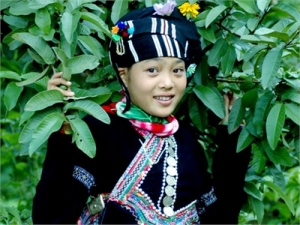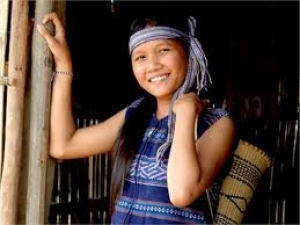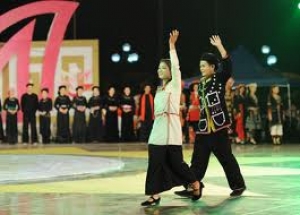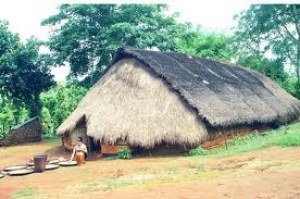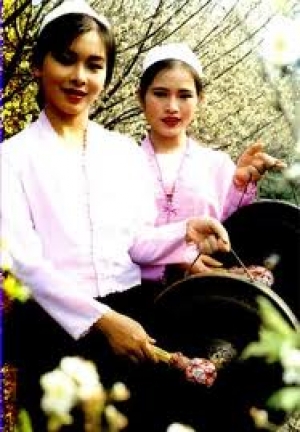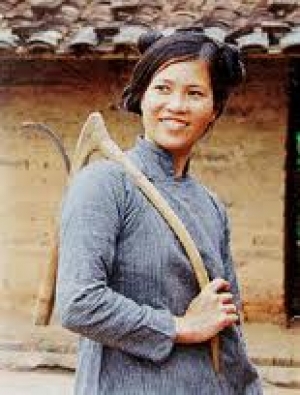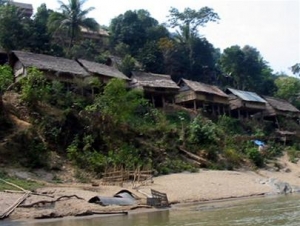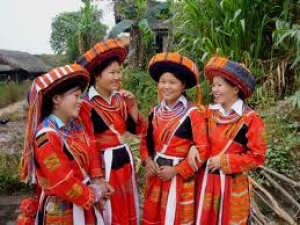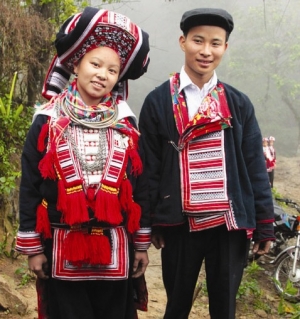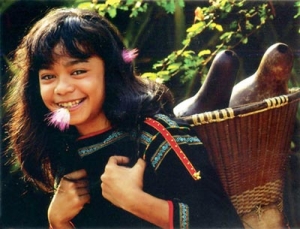
Asia Pacific Travel Team
The Lu ethnic group culture and life
Name of ethnic group: Lu (Nhuon and Duon)
Population: 4,964 people (Year 1999)
Locality: Phong Tho and Sin Ho Districts of Lai Chau Province.
Customs and habits: The Lu practice Buddhism. After their dead is buried, the family hold a rite which brings the dead's soul to the pagoda. The Lu lives in houses built on stilts with two roofs and the entrance to their homes faces the northwest.
Young men and women are free to choose their partners. Their parents' approval must be sought first, however, before the marriage can take place. The couple must then consult a fortune-teller for an age examination. If the fortune-teller finds that the ages of the couple are compatible, they can then prepare for marriage. The children take the father's family name after birth. Boys have a common middle name, "Ba", and girls, "Y". The Lu are a very friendly and faithful group of people. Divorce rarely takes place in Lu society.The Lu enjoys eating sticky rice with chilly and drinking tea.
Culture: The Lu language belongs to the Tay-Thai Group. The Lu like to sing "khap" (song verses), tell old stories, proverbs, recite poems, play flutes, two-string violins, and drums.
Costumes: Lu men wear trousers and women wear skirts. Their garments are decorated with colourful motifs on dark indigo cloths.
Economy: The Lu has been engaged in farming for a long time. The Lu also utilize slash-and-burn land to grow corn, cassava, groundnut, indigo, and cotton.
The Ma ethnic group and its plentiful traditional culture
Name of ethnic group: Ma (Chau Ma, Ma Xop, Ma To, Ma Krung, and Ma Ngan)
Population: 33,338 people (Year 1999)
Locality: Lam Dong Province.
Customs and habits: The Ma live in bons (villages). Each bon is comprised of five to ten elongated houses. The chief of a bon is called the quang bon. The family of a young man proposes marriage, but after the wedding the groom comes to live in his wife's house. Only when he has enough wedding presents to hand over to the bride's family can he take his wife to his house. The Ma believe in the existence of spirits in the river, the mountains, and the rice field.
Culture: The Ma language belongs to the Mon-Khmer Group. They possess a rich folklore including many ancient tales, myths, and legends. Their musical instruments consist of gongs, drums, pan-pipes with bamboo-boxes, horns, bamboo string zithers, and three-holed bamboo flutes.
Costumes: The women wear skirts that fall below their knees and the men wear loincloths. They also file their teeth, stretch their earlobes, and wear a lot of ornaments.
Economy: The Ma cultivate rice, corn, and cotton. Ma women are very skilled at cloth making. They are also very skillful at forging.
Come to the Mang ethnic group and discover the unique customs
Name of ethnic group: Mang (Mang U and Xa La Vang)
Population: 2,663 people (Year 1999)
Locality: Sin Ho, Muong Te, Phong Tho districts of Lai Chau Province; and Muong Cha District of Dien Bien Province.
Customs and habits: The chief of the village, together with the council of the oldest men, takes responsibility for the affairs of his village. The houses are built on stilts. Young Mang men and women are free to choose their own partners. According to customs, the two families are made to struggle for the bride on the wedding day as the bride is brought from the house of her family to worship the heavens.
Culture: The Mang language belongs to the Mon-Khmer Group. Chin tattooing is considered a rite for young men to mature into adulthood.
Costumes: Men wear garments consisting of a short vest open at the front and trousers. Women wear a long skirt, a short vest open at the front, and a piece of white cloth decorated with various motifs.
Economy: The Mang practice slash-and-burn cultivation techniques with rudimentary home-made tools. The Mang cultivate rice in terraced fields similar to the Tha and practice basketry.
The M'Nong ethnic group - The ancient, original cultural source
Name of ethnic group: M'Nong (Bru Dang, Preh, Ger, Nong, Prang, PJam, Kuyenh, Chil Bu Nor, and M'Nong Bu Dang)
Population: 92,451 people (Year 1999)
Locality: Concentrated in the southern parts of Dak Lak and Dak Nong provinces, and parts of Lam Dong and Binh Phuoc provinces.
Customs and habits: The M'Nong live in houses built on stilts or level with the ground. Each village usually has dozens of households. The village chief plays a major role in village life. They like to drink alcohol from jars with pipes and smoke tobacco threads rolled in leaves. Matriarchy is observed and the children take the family name of their mother. The wife holds the key position in the household. The M'Nong like to have many children, especially daughters. One year after the birth of a child, the baby is given a name. At funerals, people sing, and beat gongs and drums at the side of the coffin. After placing the coffin in the grave, they cover it with plants, tree boughs, and leaves before filling the grave with earth. After seven days, the family holds a rite which completes the mourning process. The M'Nong believe in the existence of many spirits which are related to their life. One such spirit is Mother Rice who has a special role.
Culture: M'Nong language belongs to the Mon-Khmer Group.
Costumes: Men generally wear loincloths and leave their upper torsos naked. Women wear skirts which fall to their ankles. Dark indigo loincloths, skirts, and vests are decorated with red-coloured designs.
Economy: The M'Nong use the slash-and-burn method of farming. The M'Nong in Ban Don are well known for their elephant hunting and domestication. Women handle the weaving of cotton cloth, while the men work on basketry.
Enjoy to national culture and tradition in the Muong ethnic group
Name of ethnic group: Muong (Moi, Mual, Moi, Moi Bi, Au Ta and Ao Ta)
Population: More than 1,137,515 people (Year 1999)
Locality: The largest population is concentrated in Hoa Binh Province and the mountainous districts of Thanh Hoa Province.
Customs and habits: In former days, the "lang dao" system characterized Muong society. The "lang dao" ruled the Muong regions. A head of a "muong" was a "lang cun", "lang xom", or "dao xom".
Muong marriage customs are similar to the Kinh. When a woman is giving birth to a child, her family surrounds the main ladder to the house with a bamboo fence. The child will be given a name when it is one year old. The Muong hold funerals with strict rules. Muong practice a polytheistic religion and ancestor worship.
Culture: The Muong language belongs to the Viet-Muong group. The popular literature and arts of the Muong are rich and include long poems, "mo" (ceremonial songs), folksongs, dialogue duets, proverbs, lullabies, and children's songs. The gong is a favorite musical instrument of the Muong, as are the two stringed violins, flutes, drums and pan pipes.
The Muong hold many ceremonies year round such as the Going to the Fields Ceremony ("Khuong Mua"), Praying-for-Rain Ceremony (during the fourth lunar month), Washing Rice Leaves Ceremony (during the seventh and eighth lunar months), and the New Rice Ritual.
Costumes: Men dress in indigo pajamas. Women wear white rectangular scarves, bras, long skirts, and short vests that are open at the front (or at the shoulders) without buttons. The skirt is complemented by a very large silk belt embroidered with various motifs such as flowers, figures, dragons, phoenixes, deer, and birds.
Economy: The Muong have practiced farming for a long time. Wet rice is their main food staple. Other family income is generated through the exploitation of forest products including mushrooms, dried fungus, ammonium, and sticklac. Muong handicrafts include weaving, basketry, and silk spinning. Muong women are known to be very skilled at loom weaving.
The traditional culture of Ngai ethnic group
Name of ethnic group: Ngai (Ngai Hac Ca, Lau Man, He, Sin, Dan, and Le)
Population: 4,841 people (Year 1999)
Locality: Quang Ninh, Bac Giang, Bac Ninh Lang Son, Cao Bang, Bac Kan and Thai Nguyen provinces.
Customs and habits: A typical Ngai house consists of three rooms. All families have ancestor altars, and all hamlets have temples and pagodas built to honour the dead. The Ngai have great respect for their ancestors, as well as souls and spirits. Young women do not receive their inheritance after their parents die. Young Ngai people must obey their parents’ wishes. Marriage is comprised of two steps: a wedding and a nuptial rite.
Culture: The Ngai language belongs to the Han group. The Ngai maintain a love duet called the "Suong Co" that exemplifies their rich cultural heritage. Other forms of entertainment include a lion dance, a stick dance and a follow-the-leader game.
Costumes: The Ngai wear garments similar to the Hoa (or Han).
Economy: The Ngai live mainly on rice cultivation and fishing. They have a very elaborate system of water irrigation as a result of digging canals, building dams and water reservoirs, and reinforcing sea dykes. They are also good at mat-making, bamboo screen making, blacksmithing, carpentry, and lime, tile and brick-baking.
"Be quite pility" - The O Du ethnic group - The smallest, the most difficult one
Name of ethnic group: O Du (Tay Hat)
Population: 301 people (Year 1999)
Locality: The O Du live in the villages of Kim Hoa and Xop Pot in Kim Da Commune, and the rest live in nearby villages in Tuong Duong District, Nghe An Province.
Customs and habits: The O Du live in small families. After marriage, the bridegroom lives at his wife's house for some time before returning to his house with his children and his wife. For the O Du, the New Year begins on the day when the thunder rolls for the first time in early spring. They believe that people have souls which, after death, become the soul of the house, watching over every activity of the living.
Culture: O Du language belongs to the Mon-Khmer Group and is now no longer used. They do use the Thai and Kho Mu languages, however. As a result, their cultural identity is obscured by the influences of the Thai and the Kho Mu.
Economy: The O Du live off of farming on slash-and-burnt plots, rearing animals, gathering, and hunting.
Weaving is also a sideline family occupation.
The Pa Then ethnic group - One loves art - culture activities very much
Name of ethnic group: Pa Then (Pa Hung and Tong)
Population: 5,569 people (Year 1999)
Locality: Concentrated in communes of Ha Giang and Tuyen Quang provinces.
Customs and habits: Pa Then houses are built either on stilts, level with the ground, or half on stilts and half on the earth. Marriage is strictly forbidden within the same lineage. According to customs, after marriage the husband lives with his wife's family for a certain amount of time. If the wife has no brothers, the husband will live with his wife's family forever, and he has to worship the spirits of his wife's family. Half of the children take the family name of their father, and the rest takes the family name of their mother. The Pa Then worship their ancestors at home. They worship the spirits of the soil and the new rice crop, pray for the rain, and worship the souls of the dead.
Culture: The Pa Then language belongs to the Mong-Dao Group. The Pa Then have managed to preserve a rich heritage of folk culture through legends, folk songs, lullabies, and dances. They also have a lot of musical instruments such as panpipes, string instruments called the "tay nhay", and bamboo flutes.
Costumes: The Pa Then costumes look very colourful. Men wear shirts, long indigo trousers, and cover themselves with a long scarf. Women wear long skirts, a bra and a shirt. They like to wear their hair wound up in a turban which is trimmed with colourful motifs.
Economy: The Pa Then live mainly on slash-and-burn cultivation. Rice and corn are their food staple.
"Robbing wife" - the strange custom of H'mong people
In spring, when the apricot flower forest blooms out with white, it signs a wedding season coming with brocade colors in many villages throughout the North West and North-East. The Mong has custom taking his beloved girl to home to become his wife (as robbing wife) As a young man who knew a girl and want her as his wife he would go and force her to his home.
Traditionally, when a boy wants to marry a girl, he will make his intentions clear, and will "rob" her during day light or night at any opportunity that is appropriate. This is traditionally only a symbolic kidnapping.
Before kidnapping her, the boy must first give a gift to the girl whom he wants to marry. After a couple of days, the boy can then kidnap the girl. If the boy has never given a gift to the girl, she is allowed to refuse and go back home with any family member who comes to save her.
The parents are not notified at the time of the kidnapping, but an envoy from the boy's clan is sent to inform them of the whereabouts of their daughter and her safety. This envoy tells the girl's family the boy's background and asks what the girl's background is.
Before the new couple enters the groom's house, the father performs a blessing ritual, asking the ancestors to accept her into the household.
The head of the household moves the chicken in a circular motion around the couple's head. The girl is not allowed to visit anyone's house for three days after this. After three days or more, the parents of the groom prepare the first wedding feast for the newlywed couple.
The wedding is usually a two-day process. The couple returns to the house of the bride's family at the end of the first wedding feast and spends the night in preparation for the next day. On the second day, the family of the bride prepares a second wedding feast at their home, where the couple will be married.
Hmong marriage customs differ slightly based on cultural subdivisions within the different Hmong community, but all require the exchange of a bride price from the groom’s family to the bride’s family.
The bride price is compensation for the new family taking the other family's daughter, as the girl's parents are now short one person to help with chores. he elders of both families negotiate the amount prior to the engagement and is usually paid in bars of silver or livestock. Today, it is also often settled in monetary terms.
Before the bride and the grooms visit the bride's family, she must wear the grooms traditional clothes.
During the wedding, there are many rules a bride must follow. When leaving the bride's house, during that process, the bride must never look back for it will make her miss her family dearly.
During the feast, no pepper dish can be served for it'll make the bride and groom's marriage life bitter.
At some point during the wedding, an elder would come ask the bride if she has any old gifts from past boyfriends. If she does, she must give them those gifts and they will return the gifts to her past boyfriends.
There is a saying that if a bride does not give her past boyfriends' gifts back, if he still really loves her and dies early, he'll come haunt her babies, which will make her babies cry a lot.
The brides maid's job is to make sure the bride doesn't run off with a guy because way back in history, many girls were forced to marry and would elope with their boyfriends.
Because the price of a bride is so high(depends on the parents), the groom's clan helps pitch in to help with the exchange of his wife. Afterwards, both the bride and groom must pay them back.
The custom of wife robbery is considered as marriage strategic mode. This process is very popular in the West – North-East. And they still keep this custom nowadays but it just a custom for form’s sake. Young H'Mong men and women are free to choose their partners. Marriages are absolutely forbidden between men and women of the same lineage. Matrimonial life of the Mong is very harmonious and divorce is very rare.
Love's H'mong people is still many exciting things. If you wonder, traveling in Vietnam travel to Northern mountains!
The cultural identity of Ede ethnic group

Festival: Festivals are celebrated in the course of the last month of the lunar year, after the harvest, but do not have a precise date. After the festival of the new rice, h’ma ngat, it is the festival mnam thun, in honor of an abundant crop. It is the largest of the year, with wealthy people killing a buffalo or an ox as an offering, and others offering a pig or poultry. The spirit the most important is Ae Die and Ae Du, the Creator, followed by the spirits of the earth, yang Ian, the spirit of rice, yang mdie, and others. The Ede are animists. The agricultural spi¬rits are the good spirits, while thunder, lightning, whirlwinds, tempests, and floods are the bad spirits. There are rituals that follow the course of a person’s life, rites that ask for happiness and health. The more rites there are, and especially those with the sacrifice of many buffaloes and oxen and great quantities of jars (for the fermentation of alcohol), the more the organizer is held in high esteem by the villagers
Calendar: The traditional agricultural calendar is fixed to the evolution of the moon. The 12-month year is divided into 9 periods corresponding to the 9 steps of agricultural work: clearing the fields, burning the vegetation, turning over the soil, weeding… Each month is comprised of 30 days.



